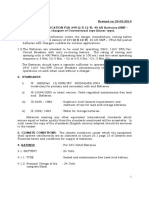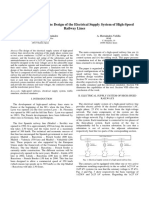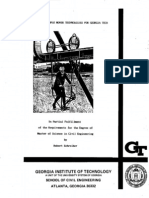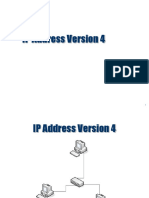Draft European Standard PrEN 50561-3
Draft European Standard PrEN 50561-3
Uploaded by
Matthew HughesCopyright:
Available Formats
Draft European Standard PrEN 50561-3
Draft European Standard PrEN 50561-3
Uploaded by
Matthew HughesCopyright
Available Formats
Share this document
Did you find this document useful?
Is this content inappropriate?
Copyright:
Available Formats
Draft European Standard PrEN 50561-3
Draft European Standard PrEN 50561-3
Uploaded by
Matthew HughesCopyright:
Available Formats
EUROPEAN STANDARD NORME EUROPENNE EUROPISCHE NORM
ICS
DRAFT prEN 50561-3
February 2014
English version
Powerline communication apparatus used in low-voltage installations Radio disturbance characteristics Limits and methods of measurement Part 3: Apparatus operating above 30 MHz
To be completed
To be completed
This draft European Standard is submitted to CENELEC members for CENELEC enquiry. Deadline for CENELEC: 2014-07-25. It has been drawn up by CLC/TC 210. If this draft becomes a European Standard, CENELEC members are bound to comply with the CEN/CENELEC Internal Regulations which stipulate the conditions for giving this European Standard the status of a national standard without any alteration. This draft European Standard was established by CENELEC in three official versions (English, French, German). A version in any other language made by translation under the responsibility of a CENELEC member into its own language and notified to the CEN-CENELEC Management Centre has the same status as the official versions. CENELEC members are the national electrotechnical committees of Austria, Belgium, Bulgaria, Croatia, Cyprus, the Czech Republic, Denmark, Estonia, Finland, Former Yugoslav Republic of Macedonia, France, Germany, Greece, Hungary, Iceland, Ireland, Italy, Latvia, Lithuania, Luxembourg, Malta, the Netherlands, Norway, Poland, Portugal, Romania, Slovakia, Slovenia, Spain, Sweden, Switzerland, Turkey and the United Kingdom. Recipients of this draft are invited to submit, with their comments, notification of any relevant patent rights of which they are aware and to provide supporting documentation. Warning : This document is not a European Standard. It is distributed for review and comments. It is subject to change without notice and shall not be referred to as a European Standard.
CENELEC
European Committee for Electrotechnical Standardization Comit Europen de Normalisation Electrotechnique Europisches Komitee fr Elektrotechnische Normung CEN-CENELEC Management Centre: Avenue Marnix 17, B - 1000 Brussels
2014 CENELEC Project: 24718 All rights of exploitation in any form and by any means reserved worldwide for CENELEC members. Ref. No. prEN 50561-3:2014 E
prEN 50561-3:2014
-2-
1 2 3 4 5 6 7 8 9 10 11 12 13 14 15 16 17 18 19 20 21 22 23 24 25 26 27 28 29 30 31 32 33 34 35 36
Contents
1 2 3 4 4.1 4.2 4.3 5 5.1 5.2 5.3 6 6.1 6.2 7 8
Page
Foreword ...........................................................................................................................................................3 Scope ....................................................................................................................................................4 Normative references ..........................................................................................................................4 Terms and definitions..........................................................................................................................5 Requirement for the frequency range below 30 MHz.......................................................................6 Requirement for conducted disturbances at AC mains power port..........................................................6 Requirement for conducted disturbances at telecommunication/network port ........................................6 Requirement for conducted disturbances and communications signals at PLC ports ............................6 Requirement for the frequency range above 30 MHz.......................................................................7 Requirement for conducted disturbances and communications signals for frequencies between 30 MHz and 87,5 MHz ...............................................................................................................7 Requirement for conducted disturbances for frequencies between 87,5 MHz and 240 MHz ..................7 Requirement for radiated disturbances for frequencies above 30 MHz ...................................................9 Measurement conditions for PLC ports ............................................................................................9 Operation conditions.................................................................................................................................9 Unsymmetric conducted emission measurements and dynamic power control between 30 and 87,5 MHz ...........................................................................................................................................9 Measurement Uncertainty .................................................................................................................10
Bibliography .......................................................................................................................................11 Annex A (normative) Excluded frequency ranges .....................................................................................12
Tables
Table 1 - Maximum unsymmetrical PLC transmit signal level between 30 and 87,5 MHz except for the frequency bands listed in Table A.1 ...............................................................................................7 Table 2 - Maximum conducted unsymmetrical disturbance signal level in the frequency bands listed in Table A.1 for services requiring increased protection....................................................................7 Table 3 - Maximum conducted unsymmetrical disturbance signal level ............................................................7 Table A.1 - Permanently excluded frequency ranges above 30 MHz ..............................................................12
Figures
Figure 1 - Maximum conducted disturbance signal level for frequencies between 30 and 240 MHz. ..............8 Figure 2 - Voltage level at AMN over attenuation between EUT and AE (linear attenuation scale). ................8 Figure 3 - Example of a test arrangement for measuring the conducted unsymmetrical voltages of the transmitted PLC signal with example of coupling device .........................................................10
prEN 50561-3:2014
-3-
37 38 39 40 41 42 43 44 45 46 47 48 49 50 51 52 53
Foreword
This document (prEN 50561-3:2014) has been prepared by Technical Committee CLC/TC 210, "Electromagnetic compatibility (EMC)". This document is currently submitted for CENELEC enquiry. This European Standard has been prepared under a mandate given to CENELEC by the European Commission and the European Free Trade Association and covers essential requirements of EN Directive(s). For the relationship with EU Directive(s) see informative Annex ZZ, which is an integral part of this document. Annex ZZ will be provided at a later stage. The scope is extended to the whole radio-frequency range from 9 kHz to 400 GHz, but limits are formulated only in restricted frequency bands, which are considered sufficient to reach adequate emission levels to protect radio broadcast and telecommunication services and to allow other apparatus to operate as intended at reasonable distance.
Sentences in red-Italic are for information only, and are not intended to be part of the standard
prEN 50561-3:2014
-4-
54 55 56 57 58 59 60 61 62 63 64 65 66 67 68 69 70 71 72 73 74 75 76 77 78 79 80 81 82 83 84 85 86 87 88 89 90 91
Scope
This part of EN 50561 specifies limits and methods of measurement of radio disturbance characteristics for in-home communication apparatus that use the low voltage power installation as the transmission medium. This part of EN50561 applies to equipment that uses frequencies including those above 30MHz in order to communicate. Equipment communicating exclusively in the frequency range from 1,6065 MHz to 30 MHz is covered in EN 50561-1. The requirements specified in this document are applicable for apparatus using frequencies of transmission up to 87.5 MHz.
NOTE: a signal level mask will ensure sufficient decay to adequately protect the reception of radio services (see figure 1).
Procedures are given for the measurement of signals generated by the equipment and limits are specified for the frequency range 9 kHz to 400 GHz. No measurement is required at frequencies where no limits are specified.
Normative references
The following documents, in whole or in part, are normatively referenced in this document and are indispensable for its application. For dated references, only the edition cited applies. For undated references, the latest edition of the referenced document (including any amendments) applies. EN 50561-1:2013, Power line communication apparatus used in low-voltage installations - Radio disturbance characteristics - Limits and methods of measurement - Part 1: Apparatus for in-home use EN 55032:2012, Electromagnetic compatibility of multimedia equipment - Emission requirements EN 55016-1-1:2010 + A1:2010, Specification for radio disturbance and immunity measuring apparatus and methods - Part 1-1: Radio disturbance and immunity measuring apparatus - Measuring apparatus EN 55016-1-2:2004 +A1:2005 + A2:2006, Specification for radio disturbance and immunity measuring apparatus and methods - Part 1-2: Radio disturbance and immunity measuring apparatus - Ancillary equipment - Conducted disturbances (CISPR 16-1-2:2003 + A1:2004 + A2:2006) EN 55016-1-4:2010 + A1:2012, Specification for radio disturbance and immunity measuring apparatus and methods - Part 1-4: Radio disturbance and immunity measuring apparatus - Antennas and test sites for radiated disturbance measurements (CISPR 16-1-4:2010 + Cor. 1:2010 + A1:2012) EN 55016-4-2:2011, Specification for radio disturbance and immunity measuring apparatus and methods Part 4-2: Uncertainties, statistics and limit modelling - Measurement instrumentation uncertainty (CISPR 164-2:2011)
prEN 50561-3:2014
-5-
92 93 94 95 96 97 98 99 100 101 102 103 104 105 106 107 108 109 110 111 112 113 114 115 116 117 118 119 120 121 122 123 124 125 126 127 128 129 130 131 132 133 134 135 136 137
Terms and definitions
For the purposes of this document, the following terms and definitions apply: 3.1 AC mains power port port that connects to the low voltage AC mains power network for the sole purpose of supplying electrical energy to the EUT 3.2 AC mains output port port of the EUT that provides AC mains power to other apparatus 3.3 Artificial Mains Network AMN provides a defined impedance at high frequencies across the power feed at the point of measurement of the terminal voltage, and also providing isolation of the circuit under test from the ambient noise on the power lines.
Note 1 to entry: Such a network is with a nominal impedance of 50 / 50 H or 50 / 50 H + 5 is defined EN 55016-1-2:2004, 4.3
3.4 Associated Equipment AE equipment needed to maintain the data traffic on the cable attached to the EUT port under test and (or) to maintain the normal operation of the EUT during the test. The associated equipment may be physically located outside the test area
Note 1 to entry: The AE can be another ITE, a traffic simulator or a connection to a network. The AE can be situated close to the measurement set-up, outside the measurement room or be represented by the connection to a network. AE should not have any appreciable influence on the test results.
3.5 Equipment Under Test EUT representative equipment used for evaluation purposes 3.6 in-Home PLC apparatus PLC apparatus that connects to the low voltage AC mains power network and intended to be linked to other PLC apparatus connected in the same home 3.7 Information Technology Equipment ITE any equipment: a) which has a primary function of either (or a combination of) entry, storage, display, retrieval, transmission, processing, switching, or control, of data and of telecommunication messages and which may be equipped with one or more terminal ports typically operated for information transfer; b) with a rated supply voltage not exceeding 600 V.
Note 1 to entry: ITE includes, for example, data processing equipment, office machines, electronic business equipment and telecommunication equipment. Note 2 to entry: Any equipment (or part of the ITE equipment) which has a primary function of radio transmission and/or reception according to the ITU Radio Regulations are excluded from the scope of this European Standard.
prEN 50561-3:2014
-6-
138 139 140 141 142 143 144 145 146 147 148 149 150 151 152 153 154 155 156 157 158 159 160 161 162 163 164 165 166 167 168 169 170 171 172 173 174 175 176 177
Note 3 to entry: Any equipment which has a function of radio transmission and/or reception according to the definitions of the ITU Radio Regulations should fulfill the national radio regulations, whether or not this publication is also valid.
3.8 PLC apparatus apparatus with a PLC port
Note 1 to entry: PLC apparatus are also called PLT apparatus
3.9 PLC port port that connects to the low voltage AC mains power network for the purpose of data transfer and communications, and may also supply electrical energy to the EUT
Note 1 to entry: PLC ports are also called PLT ports
3.10 user data
data originated from or destined to another device
3.11 telecommunications/network port point of connection for voice, data and signalling transfers intended to interconnect widely-dispersed systems via such means as direct connection to multi-user telecommunications networks (e.g. public switched telecommunications networks (PSTN) integrated services digital networks (ISDN), x-type digital subscriber lines (xDSL), etc.), local area networks (e.g. Ethernet, Token Ring, etc.) and similar networks
NOTE 1 to entry: A port generally intended for interconnection of components of an ITE system under test (e.g. RS-232, IEEE Standard 1284 (parallel printer), Universal Serial Bus (USB), IEEE Standard 1394 (Fire Wire), etc.) and used in accordance with its functional specifications (e.g. for the maximum length of cable connected to it), is not considered to be a telecommunications/network port under this definition. NOTE 2 to entry: A PLT port is not considered a telecommunications network port in the sense of this definition.
4
4.1
Requirement for the frequency range below 30 MHz
Requirement for conducted disturbances at AC mains power port
The AC mains power port of the EUT shall comply with the class B limits, using the measurement conditions and the methodology defined in EN 55032 for mains terminals.
4.2
Requirement for conducted disturbances at telecommunication/network port
The telecommunications/network port of the EUT shall comply with the class B limits, using the measurement conditions and methodology defined in EN 55032 for these ports.
4.3
Requirement for conducted disturbances and communications signals at PLC ports
The methods and limits for conducted measurements of EN 50561-1 apply for PLC apparatus for measurement frequencies 30 MHz and below. This section refers to EN 55032 for tests common to all types of ITE, as well as EN 50561-1, which refers to EN 55022 for such tests. According to the EMCD, both EN 55022 and EN 55032 are equally valid, until EN 55022 is definitely repealed, in March 2017. This will be clarified in the final version.
prEN 50561-3:2014
-7-
178 179 180 181 182 183 184 185 186 187 188
Requirement for the frequency range above 30 MHz
5.1 Requirement for conducted disturbances and communications signals for frequencies between 30 MHz and 87,5 MHz
When user data is being transmitted by the PLC port at frequencies between 30 and 87,5 MHz the unsymmetrical voltage of the transmitted signal shall not exceed the limits given in Table 1 using the methods and procedures given in clause 6.2, with the exception of the frequency bands listed in Tables A.1 for which the limits for the unsymmetrical disturbances specified in Table 2 apply. Unless otherwise noticed, limits are given in dB(V) (PK) in a 120 kHz bandwidth.
Table 1 - Maximum unsymmetrical PLC transmit signal level between 30 and 87,5 MHz except for the frequency bands listed in Table A.1
Symmetrical mode insertion loss EUT to AE in dB Maximum unsymmetrical voltages of the transmitted signal from 30 to 80 MHz, in dBV (PK) Maximum unsymmetrical voltages of the transmitted signal from 80 to 87.5 MHz in dB(V) (PK) 10 80 80 to 60 (see note 4) 25 85 85 to 60 (see note 4) 40 90 90 to 60 (see note 4)
NOTE 1: The Voltage Division Factor of the Coupling device must be taken into account. NOTE 2: The total symmetrical voltage is 6 dB above the maximum unsymmetrical voltage. NOTE 3: The transmit power management function of an AE should function in the same way as the EUT otherwise the signal of the AE may dominate and cause erroneous results during measurement. NOTE 4: The limit decreases linearly with the frequency in the range 80 to 87,5 MHz
189 190 191 192 193
Limits for 10 dB attenuation in table 1 are based on protection levels provided by EN 55022 and EN 55032 (for radiated emissions in that frequency range). Table 2 - Maximum conducted unsymmetrical disturbance signal level in the frequency bands listed in Table A.1 for services requiring increased protection
Maximum unsymmetrical voltages of the transmitted signal in dB(V) (PK)
NOTE 1: The Voltage Division Factor of the Coupling device must be taken into account. NOTE 2: The total symmetrical voltage is 6 dB above the maximum unsymmetrical voltage.
55
194 195 196 197 198 199 200
Need an AMN working at those frequencies
5.2 Requirement for conducted disturbances for frequencies between 87,5 MHz and 240 MHz
The unsymmetrical disturbances from the PLC port when transmitting user data shall comply with the disturbance limits between 87,5 and 240 MHz. Table 3 - Maximum conducted unsymmetrical disturbance signal level
Maximum unsymmetrical voltages of the transmitted signal in dB(V) (PK) 60
prEN 50561-3:2014
-8-
NOTE 1: The Voltage Division Factor of the Coupling device must be taken into account. NOTE 2: The total symmetrical voltage is 6 dB above the maximum unsymmetrical voltage.
100 level in dB(V) - peak detector values
at 40 dB attenuation at 25 dB attenuation at 10 dB attenuation
90
80
70
60 50 30 40 50 60 70 74.8 80 87.5 100 108 frequency in MHz
Figure 1 - Maximum conducted disturbance signal level for frequencies between 30 and 240 MHz.
201 202 203
NOTE: The value of 60 dB(V) continues from 87.5 MHz to 240 MHz
100 level in dB(V) - peak detector values
power management slope test points for EMC assessment
90
80
70
60 50 0 10 20 25 30 40 50 60 70 sym. attenuation between EUT and AE in dB at 100 Ohms impedance
204 205 206
Figure 2 Maximum voltage level at AMN over attenuation between EUT and AE (linear attenuation scale).
prEN 50561-3:2014
-9-
207 208 209 210 211 212 213 214 215 216 217 218 219 220 221 222 223 224 225 226 227 228 229 230 231 232 233 234 235 236 237 238 239 240 241 242 243
5.3
Requirement for radiated disturbances for frequencies above 30 MHz
When no user data is transmitted the EUT shall comply with the class B limits for measurement conditions and methodology defined in EN 55032 for radiated disturbances for frequencies between 30 MHz and 87,5 MHz In all operation conditions, the EUT shall comply with class B limits for measurement conditions and methodology defined in EN 55032 for radiated disturbances for frequencies above 87,5 MHz.
6
6.1
Measurement conditions for PLC ports
Operation conditions
The measurements of PLC ports shall be performed in conformance with EN 55032:2012, Annex B.3, table B.3 Tests requiring the PLC modem function to be active shall be performed with the condition of PLC utilization in excess of 10 % and with the transmit signal set at its maximum level for a minimum of 250 ms. As an example the transmission of a large data file could be used to exercise the port. Where this is not possible an appropriate configuration should be used that ensures the PLC transmission is active for long enough to allow for repeatable measurements in this state. No connection shall be made to any AC mains output port.
6.2 Unsymmetric conducted emission measurements and dynamic power control between 30 and 87,5 MHz
The symmetrically transmitted signals from the PLC port of the EUT shall be measured for frequencies between 30 and 87,5 MHz in order to ensure the maximum transmit signal levels are not exceeded and to ensure the presence of a dynamic power control function. The PLC port shall be exercised in accordance with the operating conditions given in Clause 6.1. Measurements shall be made using a Peak detector in accordance with the requirements of EN 55016-1-1 including the 120 kHz requirement for the 6 dB bandwidth. An example of a test arrangement, which avoids the use of a balun, is given in Figure 6.1. In this arrangement the two unsymmetrical voltages VL and VN shall be measured and compared with the limit values given in Tables 1, 2 and 3. In a symmetrical system they are equal in magnitude and of opposite phase. Each of them represents half of the total symmetrically transmitted signal. The following configurations shall be assessed: Measurements according to clause 5.1 1 2 3 with a symmetrical insertion loss between EUT and AE of 10 dB with a symmetrical insertion loss between EUT and AE of 25 dB with a symmetrical insertion loss between EUT and AE of 40 dB
Measurements according to clause 5.2 and 5.3 1 with a symmetrical insertion loss between EUT and AE of 40 dB
prEN 50561-3:2014
-10-
1.2 uH L 470 p 46.3 71.2 10 dB attenuator cell 470 p 96.3 additional attenuator cells, depending insertion loss 1.2 L
EUT
V L
AE
470 p
RX
50 Ohm 1.2 uH
N 470 p 46.3 V N 71.2 10 dB attenuator cell 470 p 96.3 additional attenuator cells, depending insertion loss 1.2
RX
50 Ohm 1.2 uH
470 p
E
(if equipped with protection earth)
E 470 p 96.3 71.2 10 dB attenuator cell 470 p 96.3 additional attenuator cells, depending insertion loss
(if equipped with protection earth)
Coupling device
1.2 E N
244 245 246 247 248 249 250 251 252 253 254 255 256 257
Mains
Figure 3 - Example of a test arrangement for measuring the conducted unsymmetrical voltages of the transmitted PLC signal with example of coupling device
NOTE 1: The Voltage Division Factor as defined in EN 55016-1-2 of this Coupling device: 20*log (50 / 96,3) = - 5.7 dB NOTE 2: In case only one receiver (RX) is used at a time, the unused interface shall be terminated with 50 .
Measurement Uncertainty
The results of measurements of signals or disturbances from PLC apparatus shall reference the measurement instrumentation uncertainty considerations where they are contained in EN55016-4-2. Determining compliance with the limits in this standard shall be based on the results of the compliance measurement, not taking into account measurement instrumentation uncertainty. However, the measurement uncertainty of the measurement instrumentation and its associated connections between the various instruments in the measurement chain shall be calculated and both the measurement results and the calculated uncertainty shall appear in the test report.
prEN 50561-3:2014
-11-
258 259 260 261 The Radio Regulations, Edition of 2012, ITU.
Bibliography
prEN 50561-3:2014
-12-
262 263 264 265 266
Annex A (normative) Excluded frequency ranges
Table A.1 - Permanently excluded frequency ranges above 30 MHz
Excluded frequency range (MHz) 50 52 70-70.5 74.8 75.2 144 146 Amateur Radio Service Amateur Radio Service Aeronautical Radio Navigation Amateur Radio Service Service
267 268 269 270 271
Note: additional frequency exclusions might be required in some countries (police/fire brigade/safety services)
Aeronautical band above 108 MHz may need to be added
You might also like
- BS 61000-3-4 1998 IecDocument16 pagesBS 61000-3-4 1998 Iecmaoviedoassaf1957100% (1)
- Control Systems Engineering Exam Reference Manual A Practical Study Guide Third EditionDocument45 pagesControl Systems Engineering Exam Reference Manual A Practical Study Guide Third EditionNaseer Hyden57% (7)
- European Standard Norme Européenne Europäische Norm: Railway Applications Electromagnetic Compatibility Part 1: GeneralDocument14 pagesEuropean Standard Norme Européenne Europäische Norm: Railway Applications Electromagnetic Compatibility Part 1: GeneralsebastiannistorNo ratings yet
- As 1085.8-2002 Railway Track Material DogspikesDocument7 pagesAs 1085.8-2002 Railway Track Material DogspikesSAI Global - APACNo ratings yet
- BS en 50123-7-2-2003Document12 pagesBS en 50123-7-2-2003Sikandar MirzaNo ratings yet
- Amodis RamonDocument4 pagesAmodis RamonfabyanoNo ratings yet
- ACS 2000AFE APPL SW Troubleshooting ManualDocument18 pagesACS 2000AFE APPL SW Troubleshooting ManualJean Carlos da SilvaNo ratings yet
- OpenRails ManualDocument85 pagesOpenRails ManualAlex GeorgeNo ratings yet
- Cloud Based BMS Data Analytics System For EV Using IOTDocument13 pagesCloud Based BMS Data Analytics System For EV Using IOTIJRASETPublicationsNo ratings yet
- Customized Guideline For Designing Overhead Contact SystemDocument157 pagesCustomized Guideline For Designing Overhead Contact SystemmustafakbNo ratings yet
- RFD 3-1-2017Document24 pagesRFD 3-1-2017vinitNo ratings yet
- Railway Application-Gauges Part 3 Struture GaugesDocument12 pagesRailway Application-Gauges Part 3 Struture GaugesErlyn AlagonNo ratings yet
- Metro Train SimulationDocument6 pagesMetro Train SimulationManishNo ratings yet
- AEC-6910 En-50155 Test ReportDocument29 pagesAEC-6910 En-50155 Test Reportd157952No ratings yet
- Report 1base Paper On STANDARDIZATION AND INDIGENISATION PDFDocument59 pagesReport 1base Paper On STANDARDIZATION AND INDIGENISATION PDFAjit PatilNo ratings yet
- BS en 50124-2-2017Document18 pagesBS en 50124-2-2017Mayada M. SalmanNo ratings yet
- EDS 06-0017 Customer Installation Earthing Design PDFDocument47 pagesEDS 06-0017 Customer Installation Earthing Design PDFRajendra Prasad ShuklaNo ratings yet
- PU85452T 2 Report EN45545 Bel+Power PDFDocument10 pagesPU85452T 2 Report EN45545 Bel+Power PDFbekbek12No ratings yet
- AC DC Railway Electrification and Protection: November 2014Document43 pagesAC DC Railway Electrification and Protection: November 2014Akhilesh kumar Srivastava100% (1)
- Railway EMC Standards PrEN 50121 XDocument7 pagesRailway EMC Standards PrEN 50121 XMvh PrasadNo ratings yet
- 21-2006Document10 pages21-2006Yogi FebriansyahNo ratings yet
- Protection Degree According IEC 60529Document3 pagesProtection Degree According IEC 60529Stefanita100% (1)
- Freight CorridorDocument27 pagesFreight CorridorRuhi SinghNo ratings yet
- Co-Simulation of An Electric Traction DriveDocument5 pagesCo-Simulation of An Electric Traction DriveElliott M.No ratings yet
- TM 3.1.3.1 Traction Power Simulations Initial Segment 090604 R0 No SigsDocument46 pagesTM 3.1.3.1 Traction Power Simulations Initial Segment 090604 R0 No SigsTarun BhatejaNo ratings yet
- Open Power Simulation - User ManualDocument278 pagesOpen Power Simulation - User ManualVsrisai ChaitanyaNo ratings yet
- Iec 62236-5-2008Document40 pagesIec 62236-5-2008Francisco Ayancan AyancanNo ratings yet
- DFCCI Corporate-Plan - 2020-2024 DP63Document80 pagesDFCCI Corporate-Plan - 2020-2024 DP63Raghvendra UpadhyaNo ratings yet
- Cispr 32Document6 pagesCispr 32singhpramod2492No ratings yet
- IESNA LM-80-08 Guide To Evaluating LED Lumen MaintenanceDocument2 pagesIESNA LM-80-08 Guide To Evaluating LED Lumen MaintenanceAlex SantiagoNo ratings yet
- Traction ModelDocument6 pagesTraction ModelARYA JENANo ratings yet
- En 50124 1 2017Document15 pagesEn 50124 1 2017akashshrivastava.1688No ratings yet
- En 50125 2 2002Document22 pagesEn 50125 2 2002BurtPersson100% (1)
- Iec 62267-2009Document132 pagesIec 62267-2009luis.alvaradoNo ratings yet
- Sist en 50206 2 2011Document11 pagesSist en 50206 2 2011gatojordanNo ratings yet
- ACS 1000 CodesStandards 3BHS232441 E01 RevADocument2 pagesACS 1000 CodesStandards 3BHS232441 E01 RevAJoão Augusto De Carvalho NaganoNo ratings yet
- Battery 24v 40ah 22 PDFDocument10 pagesBattery 24v 40ah 22 PDFramana3339No ratings yet
- Example 5.3: Power System Analysis Author: Prof. Arindam GhoshDocument1 pageExample 5.3: Power System Analysis Author: Prof. Arindam GhoshShivMeenaNo ratings yet
- 50152-1 (2012) Railway - AC - CB Above 1kVDocument28 pages50152-1 (2012) Railway - AC - CB Above 1kVshuwingNo ratings yet
- Additional DetailsDocument7 pagesAdditional Details匿匿No ratings yet
- Iec 62236-3-1-2008Document38 pagesIec 62236-3-1-2008Francisco Ayancan AyancanNo ratings yet
- A Simulation Tool For The Design of TheDocument6 pagesA Simulation Tool For The Design of ThemoisesramosNo ratings yet
- IEC 60300-3-1-2003 Application Guide - Analysis Techniques For Dependability-Guide On MethodologyDocument66 pagesIEC 60300-3-1-2003 Application Guide - Analysis Techniques For Dependability-Guide On Methodology406194645No ratings yet
- Hervmazzoni Systra 160224045832Document32 pagesHervmazzoni Systra 160224045832Ivan TaquesNo ratings yet
- Innovative Solution: Hesop: Mr. Swarup ChakrabortyDocument13 pagesInnovative Solution: Hesop: Mr. Swarup Chakrabortysubhashkpn86No ratings yet
- Relays GlossaryDocument16 pagesRelays Glossarycupid75100% (1)
- 2012 05 Public Transport Infrastructure ManualDocument203 pages2012 05 Public Transport Infrastructure ManualAlice Monteiro de BarrosNo ratings yet
- Iso 15118 1 2019Document15 pagesIso 15118 1 2019Amit SainiNo ratings yet
- Technical Standards Rail SystemDocument3 pagesTechnical Standards Rail Systemabang-abangNo ratings yet
- Caf - Regional Train SDocument3 pagesCaf - Regional Train SRodrigo SampaioNo ratings yet
- An Assessment of People MoversDocument166 pagesAn Assessment of People Moversomix8No ratings yet
- Unity Power FactorDocument6 pagesUnity Power FactorReshmi Parikal RaghavanNo ratings yet
- 6 - Best of “ Reversible Direct Current Sub-Station”Document11 pages6 - Best of “ Reversible Direct Current Sub-Station”Fernando GuedesNo ratings yet
- What Is "Reasonably Practicable" Earthing Design?Document8 pagesWhat Is "Reasonably Practicable" Earthing Design?shehan.defonsekaNo ratings yet
- C-MECN-19-003-C - CRS Mechanical Electrical Calculation NoteDocument28 pagesC-MECN-19-003-C - CRS Mechanical Electrical Calculation NoterenganayagiNo ratings yet
- Traction Systems and Components - Brochure - EnglishDocument12 pagesTraction Systems and Components - Brochure - EnglishMohamed KasemNo ratings yet
- Iso 15118 1 2019Document15 pagesIso 15118 1 2019michele.murgiaNo ratings yet
- BS EN 50124-2:2001: Railway Applications. Insulation Coordination. Overvoltages and Related ProtectionDocument2 pagesBS EN 50124-2:2001: Railway Applications. Insulation Coordination. Overvoltages and Related ProtectionMehrdad Ghaffari LalehNo ratings yet
- Railroad Signal Specialist: Passbooks Study GuideFrom EverandRailroad Signal Specialist: Passbooks Study GuideNo ratings yet
- Renewable Energy Tariffs and Incentives in Indonesia: Review and RecommendationsFrom EverandRenewable Energy Tariffs and Incentives in Indonesia: Review and RecommendationsNo ratings yet
- KITTY CASH - Setup and Configuration v1.3 - enDocument40 pagesKITTY CASH - Setup and Configuration v1.3 - en9yc94xhmp6No ratings yet
- DSLC-2XT™ Digital Synchronizer and Load ControlDocument4 pagesDSLC-2XT™ Digital Synchronizer and Load Controlcamila.simoesNo ratings yet
- M7 Main Manual 0 05 FinalDocument190 pagesM7 Main Manual 0 05 Finalrowinsitum4676No ratings yet
- Forouzan MCQ in Network Models Set 1Document10 pagesForouzan MCQ in Network Models Set 1Froyd WessNo ratings yet
- Training CourseDocument376 pagesTraining CourseHuynh DuongNo ratings yet
- Tac-Com WiFi Combo SnifferDocument8 pagesTac-Com WiFi Combo SnifferAnis ElghadiNo ratings yet
- 8Document8 pages8diego950No ratings yet
- Role of 5G Networks: Issues, Challenges and Applications: Arun Kumar Tripathi, Akash Rajak, Ajay Kumar ShrivastavaDocument7 pagesRole of 5G Networks: Issues, Challenges and Applications: Arun Kumar Tripathi, Akash Rajak, Ajay Kumar ShrivastavaShreya ShettyNo ratings yet
- GoNet MBW NMS 1.1 Operational GuideDocument116 pagesGoNet MBW NMS 1.1 Operational Guidehelberth73No ratings yet
- VXLANDocument40 pagesVXLANsureshccnaNo ratings yet
- Curriculum Vitae: Pranshu SharmaDocument4 pagesCurriculum Vitae: Pranshu SharmaPranshu SharmaNo ratings yet
- Ems GTPDocument18 pagesEms GTPSatish KumarNo ratings yet
- Nokia - 1830 - Optical - Network - Extender - Hub - Release - 4.2 - Data - Sheet - ENDocument4 pagesNokia - 1830 - Optical - Network - Extender - Hub - Release - 4.2 - Data - Sheet - ENmanhhaibcvtNo ratings yet
- Official Contest Guidelines & Criteria: I. Individual ContestsDocument6 pagesOfficial Contest Guidelines & Criteria: I. Individual ContestspiaNo ratings yet
- RUNNER™ Series: Wired & Wireless Security SolutionsDocument33 pagesRUNNER™ Series: Wired & Wireless Security Solutionscleoo2007No ratings yet
- NTRCA ICT College SyllabusDocument8 pagesNTRCA ICT College Syllabusibnhasib50% (2)
- EsasDocument47 pagesEsasLovelle Belaca-olNo ratings yet
- SP Curr Advanced End User Computing 5 20Document34 pagesSP Curr Advanced End User Computing 5 20tau.kokkyNo ratings yet
- System Config 311Document10 pagesSystem Config 311Unknown UserNo ratings yet
- Lte Kpis Are Classified Into 7 Type:: 1-Accessibility KpiDocument2 pagesLte Kpis Are Classified Into 7 Type:: 1-Accessibility KpiBromand TurkmaniNo ratings yet
- How To Trade It For Serious Profit (Even If You're A Complete Beginner)Document124 pagesHow To Trade It For Serious Profit (Even If You're A Complete Beginner)Johannes CajegasNo ratings yet
- IPv4 AddressesDocument66 pagesIPv4 AddressesAdrian AtienzaNo ratings yet
- 2.3 - Mobile CommunicationDocument31 pages2.3 - Mobile Communicationsilesh ayeleNo ratings yet
- Mocom Th10 Plus 2021 GBDocument12 pagesMocom Th10 Plus 2021 GBahmed alhouniNo ratings yet
- Fortigate Ha 50Document274 pagesFortigate Ha 50jmbrinesNo ratings yet
- Skills Matrix 2024Document3 pagesSkills Matrix 2024muddassir.nocNo ratings yet
- Paper Controlador Neuronal - CISCI-2006Document7 pagesPaper Controlador Neuronal - CISCI-2006Leonel Flores RicoNo ratings yet
- Siebel Installation Guide For UNIXDocument286 pagesSiebel Installation Guide For UNIXCholai KurapaNo ratings yet

























































































